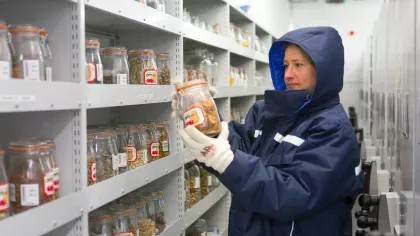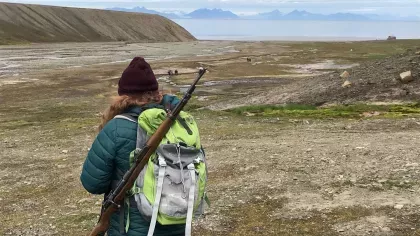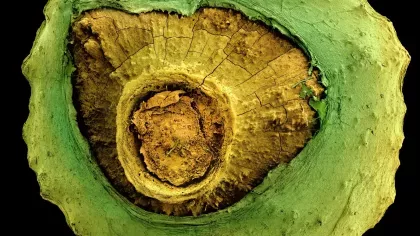29 January 2024
Watch: Why we collected nearly 300,000 seeds from the Arctic
A team of intrepid Kew scientists travelled beyond the Arctic circle, into the far north of Sweden, to save seeds from wild arctic plants.

This autumn, a team of experts from Kew and Sweden travelled to the Arctic to safeguard some of the plants most at risk from climate change.
Arctic regions have warmed nearly three times as fast as the rest of the planet. That’s why it’s essential that we safeguard Arctic plants – now.
Meet the team
The team was led by Dr. Elinor Breman, from the Millennium Seed Bank (MSB), which is housed at Wakehurst, Kew’s wild botanic garden.
She was joined by Neal Johnson from Kew’s Horticulture team – you’ll know his work from the Davies Alpine House and Rock Garden at Kew Gardens.
Alongside Neal was Dr. Stina Weststrand from Gothenburg Botanical Garden.

Together, Neal and Stina brought extensive knowledge of alpine plants to the expedition.
Sian McCabe, from Kew’s Millenium Seedbank, provided expertise on seed quality checks and processing, making sure that the seeds collected will have the greatest longevity possible in storage.
Sian has worked at the MSB for twenty years. By day, she processes orchid seeds, some of the smallest seeds on the planet, so her sharp eye was essential for working with miniscule alpine species.
The eminent Swedish biologist Mora Aronsson was also on the team. Mora has been working across the Arctic for forty years, and brought profound knowledge of the ecosystems and the species to be collected.
A film crew of two (Lydia Shellien-Walker and Andrew Brooks from the Royal Botanic Gardens, Kew) documented the work for a range of audiences, including the BBC World Service.
Why the Arctic?
Arctic regions have warmed nearly three times as fast as the rest of the planet. Another 4-7°C of warming is predicted by the end of this century.
This means that Arctic plants will experience more rapid warming than any other ecosystem on Earth.




That’s where Kew comes in.
Kew’s Millennium Seed Bank is a Noah’s Ark for plant life – collecting and storing seeds ensures that plants are safe and available to future generations.
It is also essential to visit areas where the plants grow to track changes in these ecosystems over time.
Arctic permafrost soils contain more than double the amount of carbon currently in the atmosphere. Changes in the vegetation can determine whether this carbon remains stored in soils and plant biomass or is released into the atmosphere, thus contributing to additional climate warming.
The base – Abisko Scientific Research Station
The team were based at the Abisko Scientific Research Station. Here, over 200 scientists per year stay to study climate change, ice, flora, fauna and more.

From this base, the team explored sites stunning in their beauty and amazing in their diversity.
The team collected from birch forests carpeted by berry-bearing sub-shrubs, in ericaceous heaths, alpine grasslands, rich fens and mires, and at altitude around snow-patches.


A day in the life of an Arctic seed collector
'A typical day in the field would see us set out with rucksacks full of field kit', said Elinor.
'Depending on the day, we would hike, take a boat, or jump on a chairlift to reach our collecting sites. Once there, populations would be assessed: were there enough seeds available to make a collection without impacting natural regeneration, and what was the quality of the seed?'



The team would then stick sample of seeds to Sellotape to prevent the wind blowing them away, and scissors would be used to perform cut-tests – cutting the seed in half to check that it was fully developed and at the point of dispersal.
'As we hiked, we surveyed plant populations, gathering information as we went', Elinor explained. 'Then, over coffee or lunch, we would review our collecting options, making a plan for the rest of the day.'
The team then divided up for collecting. As well as aiming to collect 10,000 seeds from each species, they also collect data such as location, other plants in the area, and land use, along with a herbarium specimen – representative plant material that would be dried and pressed to form a permanent record of the species collected.
The hut – no running water or electricity, and bathing in a freezing stream
The team’s most adventurous collecting was in Kärkevagge valley (Sami name Geargevággi), where they stayed in a tiny, wooden research hut.


The team hiked in up the mountain through strong winds and rain. With no running water or electricity, they collected drinking water from the river.
'To heat up and wash,' explained Elinor, 'we built a fire in the wood-fired sauna and bathed in the cold stream.'
The winds were strong enough to yank the door of the hut from its hinges, and to send the nearest waterfall flowing upwards.
'It is testament to the team’s dedication that even wind and rain strong enough to yank hut doors from their hinges didn’t dampen their spirits,' said Elinor, 'and 20 of our collections came from this valley.'
An amazing outcome for Arctic conservation
'Normally, we expect an average of two collections per day. On this expedition, we made 50 collections over nine days. In total we collected almost 300,000 seeds. An amazing outcome for Arctic conservation,' Elinor said.


This field work formed part of a three-year project supported by the Marris-Webbe Charitable Trust to understand and conserve the Arctic flora.
The project also includes a research team based at the University of Gothenburg, who were also in Abisko over the summer, studying some of the same species where they grow and collecting seeds for transplant experiments.
The project is already having a wide range of impacts: bringing together those working in this field to collaborate and share knowledge, and supporting the development of a Nordic seed bank network for wild plants, starting at Gothenburg Botanical Garden.


